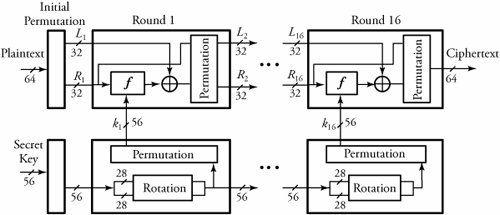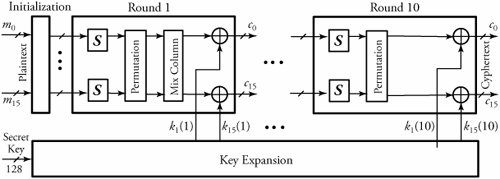Section 10.3. Secret-Key Encryption Protocols
10.3. Secret-Key Encryption ProtocolsSecret-key encryption protocols, sometimes known as symmetric encryption , or single-key encryption protocols, are conventional encryption models. They typically consist of an encryption algorithm, a key, and a decryption algorithm. At the end point, the encrypted message is called ciphertext . Several standard mechanisms can be used to implement a secret-key encryption algorithm. Here, we focus on two protocols: Data Encryption Standard (DES) and Advanced Encryption Standard (AES). In these algorithms, a shared secret key between a transmitter and a receiver is assigned at the transmitter and receiver points. The encryption algorithm produces a different key at any time for a specific transmission. Changing the key changes the output of the algorithm. At the receiving end, the encrypted information can be transformed back to the original data by using a decryption algorithm and the same key that was used for encryption. The security of conventional encryption depends on the secrecy of the key, not on the secrecy of the encryption algorithm. Consequently, the algorithm need not be kept secret; only the key has to be secret. 10.3.1. Data Encryption Standard (DES)With the Data Encryption Standard (DES), plaintext messages are converted into 64-bit blocks, each encrypted using a key. The key length is 64 bits but contains only 56 usable bits; thus, the last bit of each 8 byte in the key is a parity bit for the corresponding byte. DES consists of 16 identical rounds of an operation, as shown in Figure 10.3. The details of the algorithm on each 64-bit block of message at each round i of operation are as follows . Begin DES Algorithm
Figure 10.3. The Data Encryption Standard (DES) The operation of function F() at any round i of DES is as follows.
Equation 10.4 At the receiver, the same steps and the same key are used to reverse the encryption. It is now apparent that the 56-bit key length may not be sufficient to provide full security. This argument is still controversial . Triple DES provides a solution for this controversy: three keys are used, for a total of 168 bits. It should also be mentioned that DES can be implemented more efficiently in hardware than in software. 10.3.2. Advanced Encryption Standard (AES)The Advanced Encryption Standard (AES) protocol has a better security strength than DES. AES supports 128-bit symmetric block messages and uses 128-, 192-, or 256-bit keys. The number of rounds in AES is variable from 10 to 14 rounds, depending on the key and block sizes. Figure 10.4 illustrates the encryption overview of this protocol, using a 128-bit key. There are ten rounds of encryptions for the key size of 128 bits. All rounds are identical except for the last round, which has no mix-column stage. Figure 10.4. Overview of Advanced Encryption Standard (AES) protocol A single block of 128-bit plaintext (16 bytes) as an input arrives from the left. The plaintext is formed as 16 bytes m through m 15 and is fed into round 1 after an initialization stage. In this round, substitute unitsindicated by S in the figure perform a byte-by-byte substitution of blocks. The ciphers, in the form of rows and columns , move through a permutation stage to shift rows to mix columns. At the end of this round, all 16 blocks of ciphers are Exclusive-ORed with the 16 bytes of round 1 key k (1) through k 15 (1). The 128-bit key is expanded for ten rounds. The AES decryption algorithm is fairly simple and is basically the reverse of the encryption algorithm at each stage of a round. All stages of each round are reversible. |
EAN: 2147483647
Pages: 211
 is a logic Exclusive-OR, and the description of function
is a logic Exclusive-OR, and the description of function